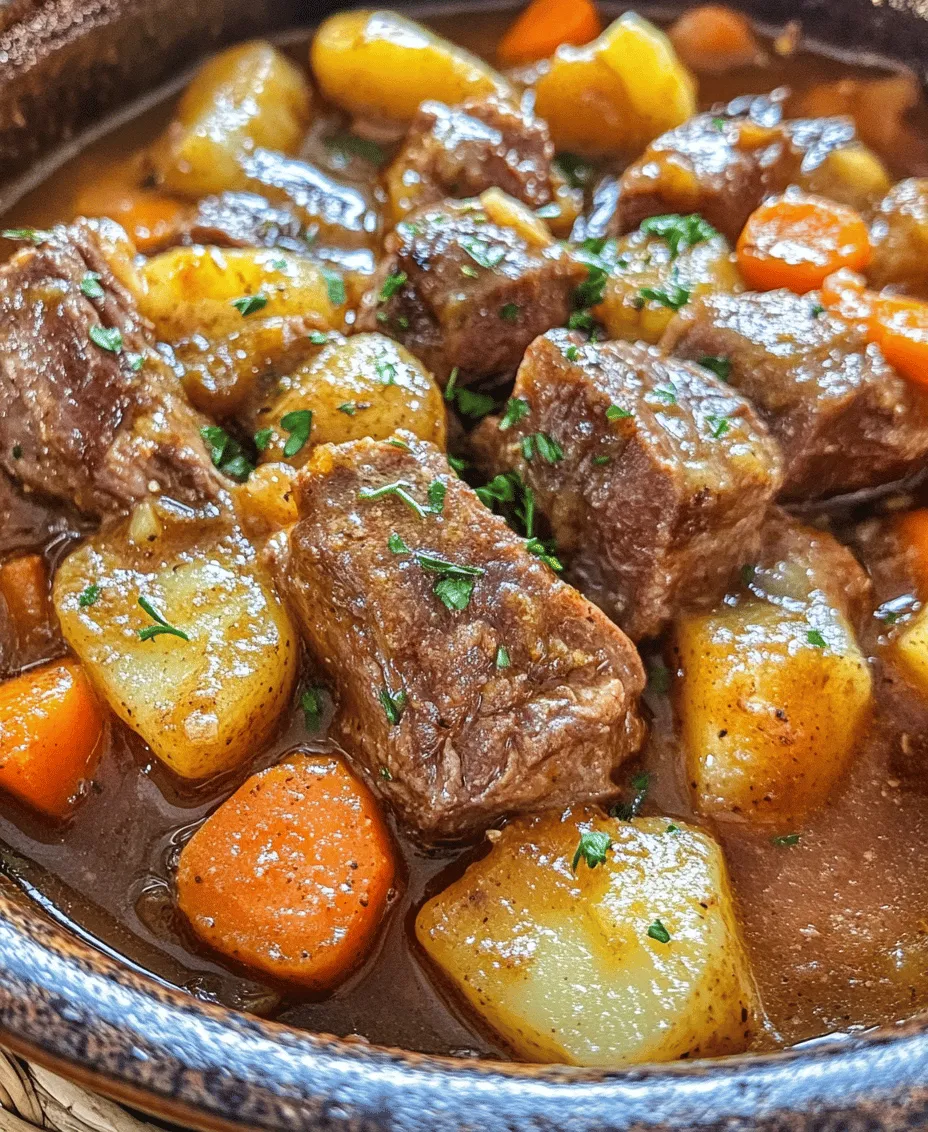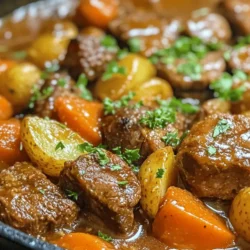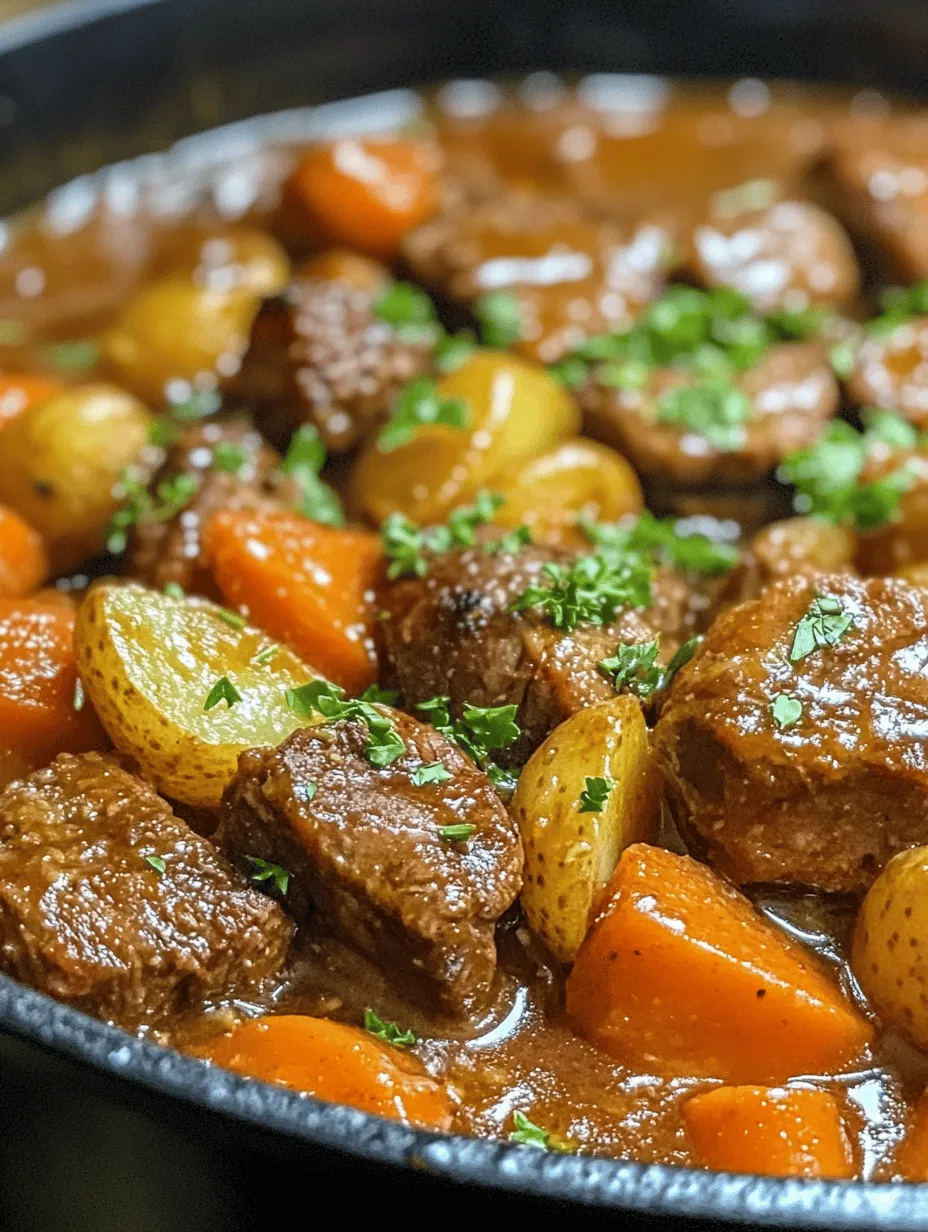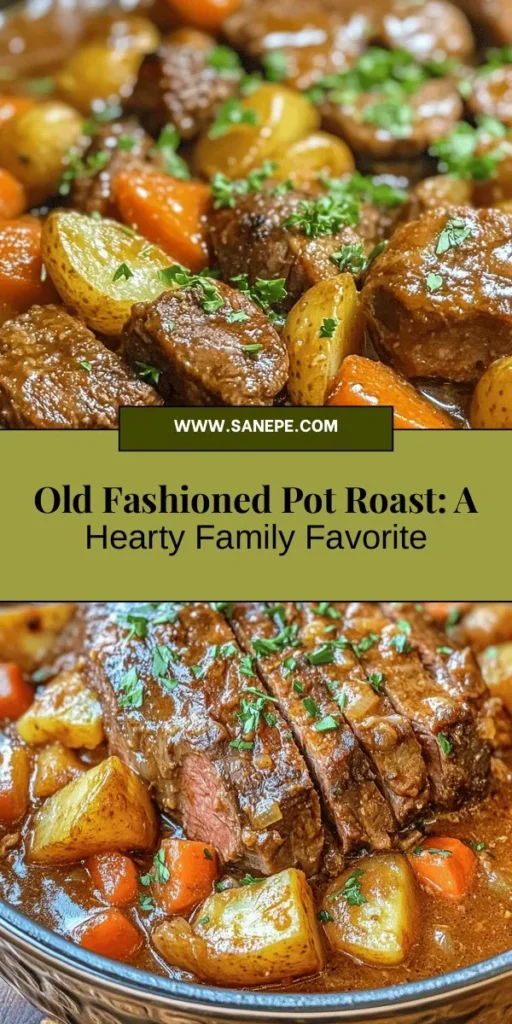Introduction
In the realm of comfort food, few dishes evoke the same sense of nostalgia and warmth as a classic pot roast. This hearty meal has been a staple in kitchens for generations, embodying the essence of home-cooked comfort. Whether it’s a rainy Sunday afternoon or a special family gathering, the aroma of a pot roast simmering in the oven creates an inviting atmosphere that draws everyone to the table. The tender, succulent meat paired with flavorful vegetables brings not just sustenance but also a sense of togetherness, making pot roast a beloved favorite across many cultures.
The timeless appeal of a well-cooked pot roast lies in its simplicity and the deep, rich flavors that develop during the slow cooking process. As the meat braises gently with aromatic vegetables and savory herbs, it transforms into a dish that is both satisfying and nourishing. This recipe for Old Fashioned Pot Roast is not just about filling your belly; it’s about creating cherished memories around the dinner table. Let’s delve into the heart of this classic dish and explore the essential steps to create a pot roast that will be the star of your next family meal.
Understanding Pot Roast
Pot roast, by definition, is a method of cooking meat—typically a tougher cut—slowly in a covered pot with liquid. The origins of this comforting dish can be traced back to various culinary traditions, with roots in European cooking methods that favored slow braising. Historically, pot roast was a practical way to utilize less expensive cuts of meat, transforming them into tender, flavorful dishes through low, slow cooking. This method not only makes the meat more palatable but also allows the flavors of the accompanying ingredients to meld beautifully.
In many households, pot roast is synonymous with family gatherings and traditional meals, often making an appearance during holidays or special occasions. The communal act of sharing a pot roast dinner fosters a sense of connection and warmth, bringing friends and family together around the table. Beyond its social significance, pot roast is also packed with nutritional benefits. The beef chuck roast is rich in protein and essential vitamins, while the vegetables like carrots and potatoes provide fiber, vitamins, and minerals, making it a balanced and hearty meal.
Essential Ingredients for Old Fashioned Pot Roast
To create the perfect Old Fashioned Pot Roast, it’s crucial to select high-quality ingredients that will contribute to the overall flavor and texture of the dish. The main ingredient, of course, is the beef chuck roast, a cut known for its marbling and connective tissue, which breaks down beautifully during the slow cooking process. This results in a tender and juicy roast that is the hallmark of a successful pot roast.
Next, consider the aromatics. Onions and garlic play a pivotal role in building a robust flavor base. When sautéed, onions caramelize beautifully, adding sweetness and depth, while garlic infuses the dish with its aromatic essence. These two ingredients are essential for elevating the overall taste profile of the pot roast.
To enhance the flavors, a splash of red wine and beef broth is added. The wine not only adds acidity, which balances the richness of the meat, but also contributes complex flavors that deepen as the dish cooks. Beef broth serves as the cooking liquid, ensuring that the meat stays moist and infuses it with additional savory notes.
The significance of vegetables cannot be overstated. Carrots and potatoes are traditional accompaniments that not only complement the meat but also absorb the delicious flavors of the braising liquid. Their natural sweetness and hearty texture make them perfect companions for pot roast, providing a complete meal in one pot.
Lastly, herbs and seasonings like thyme, bay leaves, Worcestershire sauce, and tomato paste are essential for adding layers of flavor. Thyme and bay leaves impart earthy notes, while Worcestershire sauce contributes umami richness. Tomato paste adds a touch of acidity and depth, ensuring that every bite is bursting with flavor.
Step-by-Step Guide to Preparing Old Fashioned Pot Roast
Preparation
Before you start cooking, it’s important to prepare your ingredients and equipment. One key step is to bring your beef chuck roast to room temperature. This helps to ensure even cooking, allowing the roast to sear properly and retain its juices during the braising process. While the meat rests, you can chop your vegetables and gather your aromatics, making the cooking process more efficient.
Searing the Meat
One of the most critical steps in preparing a pot roast is searing the meat. This is where the Maillard reaction occurs, a chemical process that enhances the flavors and creates a deep, brown crust on the surface of the meat. To achieve this, heat a large Dutch oven or heavy pot over medium-high heat and add a bit of oil. Once the oil is shimmering, carefully place the roast in the pot. Allow it to sear undisturbed for several minutes until a rich brown crust forms. This caramelization is key to building a flavor foundation for your pot roast and will enhance the overall taste of the finished dish.
Sautéing Aromatics
After the meat is beautifully seared, it’s time to sauté the aromatics. Remove the roast from the pot and set it aside on a plate. In the same pot, add chopped onions and minced garlic, stirring them in the residual fat left from the roast. Sautéing these ingredients not only releases their natural flavors but also deglazes the pot, lifting those flavorful brown bits stuck to the bottom. This step is crucial, as it adds depth to the braising liquid and ensures that every component of the dish is infused with flavor.
As the onions become translucent and fragrant, you can begin to add the remaining ingredients, including the red wine and beef broth. This will create a rich, savory base for your Old Fashioned Pot Roast, ensuring that each bite is as delicious as the last.
The process of preparing a pot roast is steeped in tradition and love, as each step builds upon the last to create a dish that is not only flavorful but also deeply satisfying. In the next part of this article, we will explore the final steps in creating this classic comfort dish, detailing how to combine all the elements and allow the pot roast to cook to perfection.

Classic Comfort: Old Fashioned Pot Roast
Deglazing: Importance of Red Wine in Flavor Enhancement
Deglazing is a crucial step in the pot roast preparation that significantly enhances the flavor of your dish. After searing the beef, the fond (the caramelized bits stuck to the bottom of the pot) holds an enormous amount of flavor. By adding red wine to the pot, you not only loosen these flavorful bits but also introduce a deep, rich taste that complements the beef beautifully.
Red wine brings acidity, which balances the richness of the meat and helps tenderize it as it cooks. Look for a dry red wine, such as Cabernet Sauvignon or Merlot, which will impart a robust flavor. When deglazing, ensure you scrape the bottom of the pot thoroughly with a wooden spoon to incorporate every bit of that delicious fond back into your dish. Allow the wine to simmer for a few minutes to cook off the alcohol and concentrate its flavors, creating a harmonious base for your pot roast.
Building Flavor: Combining Broth, Worcestershire Sauce, and Tomato Paste
Once you’ve deglazed the pot, it’s time to build layers of flavor. Start by adding beef broth, which serves as the primary liquid for braising the roast. The broth should cover about two-thirds of the meat to ensure it stays moist during cooking.
Next, stir in a couple of tablespoons of Worcestershire sauce, which adds a savory umami note, enhancing the overall flavor profile. This sauce is packed with complex flavors that complement the beef and work seamlessly with other ingredients.
Finally, include a tablespoon or two of tomato paste. This may seem unusual, but it contributes a subtle sweetness and depth of flavor. The acidity in the tomato paste also aids in breaking down the meat fibers, resulting in a tender roast. Mix these ingredients well, ensuring they are evenly distributed in the pot.
Adding Vegetables: Tips for Even Cooking and Flavor Distribution
Vegetables are essential in a classic pot roast, not just for flavor but also for nutrition. Carrots, potatoes, and onions are traditional staples that absorb the rich broth’s flavors as they cook.
To ensure even cooking and flavor distribution, cut your vegetables into uniform sizes. For example, slice carrots into 1-inch pieces and chop potatoes into quarters. This will ensure that all vegetables cook at the same rate and absorb the delicious juices from the roast.
When adding vegetables to the pot, place them around the roast rather than on top. This allows them to cook evenly while being infused with the meat’s juices. If you’re feeling adventurous, consider adding additional vegetables like parsnips or turnips for a unique twist on the classic recipe.
Cooking Techniques: Simmering Versus Oven Cooking; Pros and Cons
When it comes to cooking your pot roast, you have two primary methods: simmering on the stovetop or braising in the oven. Both techniques yield delicious results, but they come with their own set of pros and cons.
Stovetop Simmering: This method allows for easy monitoring and adjusting of heat. It can be quicker to bring to a boil and then reduce to a simmer. However, it requires more attention to prevent burning, and you may need to occasionally add water or broth to maintain the liquid level.
Oven Braising: This method is often favored because it allows for even cooking in a controlled environment. You can set your oven to a low temperature (around 300°F) and let the pot roast cook gently for several hours. The even heat distribution of the oven helps break down the meat’s fibers, resulting in an exceptionally tender roast. However, this method requires more time and can be less convenient if you need to adjust the cooking process frequently.
Ultimately, both methods can yield a delicious pot roast, so choose the one that fits your schedule and cooking style.
Cooking Time and Techniques for Perfect Pot Roast
The cooking time for pot roast will vary depending on the size of the meat cut and the cooking method used. As a general guideline, for a 3 to 4-pound roast, you should plan for approximately 3 to 4 hours of cooking time in the oven or 2 to 3 hours on the stovetop.
To determine if your roast is done, look for a fork-tender texture. This means you should be able to easily pierce the meat with a fork, and it should pull apart with little effort. A meat thermometer can also be a helpful tool; the internal temperature should reach around 190°F to 205°F for optimal tenderness.
The science of slow cooking is vital to achieving a delicious pot roast. The low and slow cooking process allows collagen in the meat to break down, transforming tough cuts into tender, melt-in-your-mouth dishes. This extended cooking time allows flavors to meld beautifully, resulting in a comforting meal that’s perfect for sharing.
Serving Suggestions for Old Fashioned Pot Roast
When it comes time to serve your old-fashioned pot roast, consider pairing it with complementary side dishes that enhance the meal’s comforting essence.
Ideal Side Dishes: Crusty bread is a classic choice, perfect for soaking up the savory juices from the roast. A simple green salad can provide a refreshing contrast to the rich flavors of the pot roast. Consider roasted or steamed vegetables, which can add color and additional nutrients to your meal.
Creative Ways to Serve Leftovers: Pot roast leftovers can be transformed into a variety of delicious meals. Shred the meat and use it in sandwiches, pairing it with horseradish sauce or mustard for a flavorful bite. Alternatively, you can incorporate the roast into casseroles or soups, adding additional vegetables and broth to create a hearty meal.
Presentation Tips: For a comforting family meal, serve the pot roast directly from the Dutch oven or transfer it to a large serving platter. Garnish with fresh herbs, such as parsley or thyme, for a pop of color. Arrange the vegetables around the roast, showcasing their vibrant hues, and encourage everyone to help themselves to seconds.
Cultural Variations and Adaptations of Pot Roast
Pot roast is a dish that transcends cultural boundaries, with regional variations and adaptations found across the globe. In the American South, for example, you might find pot roast served with a side of cornbread, while in the UK, it’s often accompanied by Yorkshire pudding.
Modern adaptations of pot roast have also emerged, with many home cooks exploring healthier or vegetarian versions. Substituting the beef with hearty vegetables like mushrooms or seitan can create a delightful dish that captures the essence of pot roast without the meat.
Pairing wine and sides with pot roast can also enhance the dining experience. A robust red wine, such as a Syrah or Zinfandel, complements the flavors beautifully. Additionally, consider serving a side of roasted Brussels sprouts or a creamy mashed potato dish for a well-rounded meal.
Conclusion
The comforting essence of an old-fashioned pot roast evokes memories of family gatherings and heartwarming meals shared around the dinner table. As you embrace the slow cooking tradition, remember that preparing this timeless dish is not just about the food; it’s about creating moments with loved ones that will be cherished for years to come.
The joy of crafting a pot roast lies in the process: the careful selection of ingredients, the soothing simmering sounds, and the delightful aromas that fill your home. By incorporating these tips and techniques, you’re sure to create a pot roast that not only satisfies your family’s appetite but also warms their hearts.
So, gather your ingredients, roll up your sleeves, and embark on this culinary journey. Your old-fashioned pot roast awaits, ready to become a beloved centerpiece at your family meals for generations to come.


